Life
Here's How To Get iOS 11 On Your Device
Just when you got the hang of last year's software update — that whole 3D Touch business takes some getting used to — Apple is releasing another major change. For the less-than-technologically-savvy, step one isn't exploring the cool new features that come with iOS 11. It's figuring out how to get iOS 11 in the first place. Although my preferred method of tech support is begging the nearest adolescent for help while I poke uselessly at my phone screen, maybe you want to save face and do it yourself. Luckily, the process is super easy.
For several years now, Apple has released a major update to its operating system in September, and this year is no different. On Tuesday, it was revealed that iOS 11 will become available for most phones starting Sept. 19. When Apple accidentally dropped the firmware for HomePod speakers back in July, developers scoured the code for clues about new iPhone features and, naturally, tweeted about their findings.
But while some surprises were spoiled in advance, that doesn't change the fact that the update brings all kinds of new features, including "livelier" Live Photos, fancy wallpapers, and animated versions of emoji characters called "Animoji." There's even allegedly a one-handed keyboard, for all those times you're too lazy to hold your phone with both hands.
Obviously, this leaves the question of how you're supposed to actually update your phone. The public beta version of iOS 11 has been available for a while, allowing people who aren't registered developers to test out the software (and all the new stuff that comes along with it) for free before it's released. This tends to come with bugs and slow performance, though, so most people choose to wait for the traditional update.
Now that the release date has rolled around, you can get your hands on the final, official version. Here's a step-by-step guide to installing iOS 11 on your Apple devices.
Back Up Your Device
First, as always, prepare for something to go wrong. With the official release, glitches and lost data are unlikely, but having an extra copy of your information can't hurt. To find out how to back up your device, check out Apple's guide to backups on the company's website. You can choose to store your data on iTunes, the iCloud, or if you're really worried, both.
Start Charging
Updates use up a substantial amount of power. As you may have noticed, most devices require a minimum charge before they begin an update. To err on the side of caution, plug your device into power before you begin.
Connect To Wifi Or iTunes
If you prefer to manually update, connect your device to your computer and open the latest version of iTunes. Select your device, then click Summary, which is found under Settings. Click Check for Update, and proceed from there.
To download the update wirelessly, make sure you're connected to (functional) wifi on your device and take the following steps.
Open Settings
Next, go to the Settings menu. Scroll down and tap General. At the top of the screen, underneath About, you should see Software Update.
Tap Software Update
Tapping Software Update automatically causes your device to check for new updates. As of Sept. 19, iOS 11 is the newest version, so this should be pulled up. (Previously, the most recent version was iOS 10.3.3.)
Download And Install
Finally, there should be an option to download and install the update. Tap that, and you should be good to go. According to the Apple website, your device might temporarily remove some apps to make room for the update, but they will reappear after it's installed.
If you want to update immediately after iOS 11 finishes downloading, tap "install now" when prompted; otherwise, you can select an option to install later. If you have any issues updating, you can always check out the Apple Support page. Remember — no question is so dumb it hasn't been asked before.
Once iOS 11 is installed, you can get on to the fun part: getting the hang of the update's new features.
